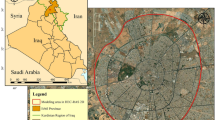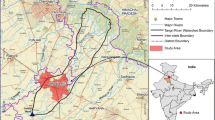Abstract
Flooding in the Philippines is becoming more hazardous over the years intensified by climate change, poor drainage and expanding agricultural industries. In managing this natural disaster, flood hazard maps serve as a significant tool to local government in enabling them for adequate disaster response and planning. Through flood simulation and mapping using numerical models and GIS techniques, this study aimed to determine the amount of flood exposed building features and agricultural resources to different flood scenarios in the floodplain of Sawaga watershed. The Hydrologic Engineering Center’s, hydrologic modeling system and river analysis system of the US Army Corps were the models used for the flood simulation. Feature datasets utilized for flood exposure analysis were derived from Light Detection and Ranging data and satellite images. Results revealed that of the 12 flood-prone barangays in Sawaga floodplain, four (Managok, Santo Niño, Simaya, and Violeta) are most exposed to flood hazards when it comes to the count of affected building features and area of flood-exposed agricultural cultivations. Residential buildings associated as the local community are the most exposed to flood hazard accounting 94% of the total affected building features for all flood scenarios. Moreover, rice plantation is the most exposed agricultural land use to the flood hazard constituting 66%, 74% and 77% of the total flooded agricultural cultivation in the floodplain by the 5-year, 25-year, and 100-year return period scenarios, respectively. The generated maps and extracted information will serve as viable tools to guide disaster managers in the city in executing informed decisions in facing the onslaught of flood disasters.









Similar content being viewed by others
References
Senate Economic Planning Office. (2013). Natural disaster at a glance. https://www.senate.gov.ph/publications. Accessed August 8, 2017.
Ogania, J. L., Puno, G. R., Alivio, M. B. T., & Taylaran, J. M. G. (2019). Effect of digital elevation model’s resolution in producing flood hazard maps. Global Journal of Environmental Science and Management.,5(1), 95–106.
Talisay, B. A. M., Puno, G. R., & Amper, R. A. L. (2019). Flood hazard mapping in an urban area using combined hydrologic-hydraulic models and geospatial technologies. Global Journal of Environmental Science and Mangement,5(2), 139–154.
National Disaster Coordinating Council Republic of the Philippines. (2005). Natural disaster risk management in the Philippines: Enhancing poverty alleviation through disaster reduction. The World Bank East Asia and Pacific Region Rural Development and National Disaster Coordinating Council Republic of the Philippines. http://documents.worldbank.org/curated/en/975311468776739344/pdf/338220REPLACEM1aster0Report1combine.pdf. Accessed August 8, 2017.
Supharatid, S., Aribarg, T., & Supratid, S. (2016). Assessing potential flood vulnerability to climate change by CMIP3 and CMIP5 models: case study of the 2011 Thailand great flood. J. Water Clim. Change,7(1), 52–67.
Puno, G. R., Talisay, B. A. M., & Paquit, J. C. (2016). GIS-based flood hazard mapping in Gingoog river. Mindanao. CMU Journal of Science,20(3), 81–96.
Bukidnon News. (2012). Bukidnon after Typhoon Pablo—damages, reports, data. http://www.bukidnononline.com/bukidnon-after-typhoon-pablo-damages/. Accessed February 26, 2018.
Malaybalay, L. G. U. (2015). The final comprehensive land use plan 2016–2025. Bukidnon, Philippines: Malaybalay City.
National Disaster Risk Reduction and Management Council. (2015). NDDRRMC Update SitRep No. 19 re Effects of Tropical Storm “Seniang”, NDRRMC, Quezon City, Philippines. https://reliefweb.int/sites/reliefweb.int/files/resources/SitRep_No_19_re_Effects_of_Tropical_Storm_Seniang_%28Jangmi%29_as_of_07JAN2015_0800H.pdf. Accessed February 26, 2018.
Puno, G. R., & Amper, R. A. L. (2016). Flood modeling of Musimusi river in Balingasag, Misamis Oriental. CMU Journal of Science,20(3), 150–165.
Association of State Floodplain Managers. (2013). Flood mapping for the nation: A cost analysis for the nation’s flood map inventory, 2013, Wisconsin, USA. https://www.floods.org/ace-files/documentlibrary/2012_NFIP_Reform/Flood_Mapping_for_the_Nation_ASFPM_Report_3-1-2013.pdf. Accessed February 26, 2018.
Knebl, M. R., Yang, Z. L., Hutchison, K., & Maidment, D. R. (2004). Regional scale flood modelling using NEXRAD rainfall, GIS, and HEC-HMS/RAS: a case study for the San Antonio river basin summer 2002 storm event. Journal of Environmental Management,75(2005), 325–336.
Alivio, M. B. T., Puno, G. R., & Talisay, B. A. M. (2019). Flood hazard zones using 2d hydrodynamic modeling and remote sensing approaches. Global Journal of Environmental Science and Management,5(1), 1–16.
Puno, G. R., Amper, R. A. L., & Talisay, B. A. M. (2018). Flood simulation using geospatial and hydrologic models in Manupali watershed, Bukidnon, Philippines. Journal of Biodiversity and Environmental Sciences,12(3), 294–303.
Haile, A. T. (2005). Integrating hydrodynamic models and high resolution DEM (LIDAR) for flood modelling. Dissertation, International Institute for Geo-information Science and Earth Observation.
Minaei, M., & Kainz, W. (2016). Watershed land cover/land use mapping using remote sensing and data mining in Gorganrood, Iran. ISPRS International Journal of Geo-Information,5(5), 57.
UP DREAM. (2016). The UP DREAM Program.
UP TCAGP. (2015). DREAM Flood Forecasting and Flood Hazard Mapping for Iponan River Basin. Disaster Risk and Exposure Assessment for Mitigation (DREAM) Program, DOST Grants-In-Aid Program, UP Training Center for Applied Geodesy and Photogrammetry, Quezon City, Philippines.
USACE. (2008). Hydrologic Modeling System HEC-HMS Applications Guide March 2008. United States Army Corps of Engineers, Hydrologic Engineering Center, Davis, California, USA.http://www.hec.usace.army.mil/software/hec-hms/documentation/HEC-HMS_Applications_Guide_March2008.pdf. Accessed February 26, 2018.
Oleyiblo, J. O., & Li, Z. (2010). Application of HEC-HMS for flood forecasting in Misai and Wan’an catchments in China. Water Science and Engineering,3(1), 14–22.
Razi, M. A. M., Ariffin, J., Tahir, W., & Arish, N. A. M. (2010). Flood estimation studies using hydrologic modeling system (HEC-HMS) for Johor river, Malaysia. Journal of Applied Sciences,10(11), 930–939.
Zema, D. A., Labate, A., Martino, D., & Zimbone, S. M. (2016). Comparing different infiltration methods of the HEC-HMS model: the case study of the Mesima torrent (southern Italy). Land Degradation and Development,28, 294–308.
Reshma, T., Venkata Reddy, K., & Deva, P. (2013). Simulation of event based runoff using HEC-HMS model for an experimental watershed. International Journal of Hydraulic Engineering,2(3), 42–46.
Chatterjee, M., De, R., Roy, D., Das, S., & Mazumdar, A. (2014). Hydrological modeling studies with HEC-HMS for Damodar basin, India. World Applied Sciences Journal,31(12), 2148–2154.
Puno, G. R., & Barro, R. A. I. (2016). Alubijid river basin hydrologic modeling in Misamis Oriental for flood risk management. CMU Journal of Science,20(3), 97–106.
USACE. (2016). HEC-RAS river analysis system. Hydraulic Reference Manual version 5.0 February 2016. United States Army Corps of Engineers Institute for Water Resources Hydrologic Engineering Center (HEC) Davis, California, USA. http://www.hec.usace.army.mil/software/hec-ras/documentation/HEC-RAS%205.0%20Reference%20Manual.pdf. Accessed on February 26, 2018.
Zhang, H. L., Wang, Y. J., Wang, Y. Q., Li, D. X., & Wang, X. K. (2013). The effect of watershed scale on HEC-HMS calibrated parameters: A case study in the Clear Creek watershed in Iowa, US. Hydrology and Earth System Sciences,17, 2735–2745.
Moriasi, D. N., Arnold, J. G., Van Liew, M. W., Bingner, R. L., Harmel, R. D., & Veith, T. L. (2007). Model evaluation guidelines for systematic quantification of accuracy in watershed simulations. American Society of Agriculture and Biological Engineers,50(3), 885–900.
ASABE. (2017). Guidelines for calibrating, validating, and evaluating hydrologic and water quality (H/WQ) models. American Society of Agricultural and Biological Engineers. https://swat.tamu.edu/media/115778/ep621.pdf. Accessed on February 26, 2018.
Qasim, J. M. (2013). Laboratory and HEC-RAS simulations of a single-step weir. ARPN JEAS,8(12), 1005–1011.
Ali, M. F., Kamarudin, A. F., Khalid, K., & Abd Rahman, N. F. (2013). Integration of HEC-RAS and geographical information system (GIS) in the hydrological study of peak flow response to deforestation on a small watershed in Malaysia. International Journal of Water Resources and Environmental Engineering,5(3), 146–151.
Kalaba, D. V., Ivanovic, I. B., Cikara, D. M., & Milentijevic, G. O. (2014). The initial analysis of the river Ibar temperature downstream of the lake Gazivode. Thermal Science,18(1), 73–80.
Kute, S., Kakad, S., Bhoye, V., & Walunj, A. (2014). Flood modeling of river Godavari using HEC-RAS. International Journal of Research in Engineering and Technology,3(9), 81–87.
Sui, J. (2005). Ice jams in a small river and the HEC-RAS modeling. Journal of Hydrodynamics,17(2), 127–133.
Dhital, M. R., Shrestha, R., Ghimire, M., Shrestha, G. B., & Tripathi, D. (2005). Hydrological hazard mapping in Rupandehi district, west Nepal. Journal of Nepal Geological Society,31, 59–66.
Alaghmand, S., Abdullah, R., Abustan, I., & Vosoogh, B. (2010). GIS-based river flood hazard mapping in urban area (a case study in Kayu Ara river basin, Malaysia). International Journal of Engineering and Technology,2(6), 488–500.
Mehta, D., Yadav, S. M., & Waikhom, S. (2013). Geomorphic channel design and analysis using HEC-RAS hydraulic design functions. Global Research Analysis,2(4), 90–93.
Adamowski, J. (2010). Flood routing in the Ogunpa river in Nigeria using HEC-RAS. Journal of Environmental Hydrology,18, 1–11.
Ambiental. (2013). Final brisbane validation: 2011 Brisbane flood model validation. The Sussex Innovation Centre, Science Park Square, Brighton, BN1 9SB, UK. https://www.ambiental.co.uk/wp-content/uploads/2018/07/Brisbane_Validation_Report.pdf. Accessed on February 27, 2018.
Earth Observation. (2016). Earth Observation Portal Directory. https://directory.eoportal.org/web/eoportal/satellite-missions/c-missions/copernicus-sentinel-2. Accessed August 7, 2016.
Alberto, R. T., Serrano, S. C., Damian, G. B., Camaso, E. E., Celestino, A. B., Hernando, P. J. C., et al. (2016). Object based agricultural land cover classification map of shadowed areas from aerial image and lidar data using support vector machine. ISPRS Annals of the Photogrammetry, Remote Sensing and Spatial Information Sciences,3(7), 1–6.
Blanco, A. C., Tamondong, A. M., Perez, A. M. C., Ang, M. R. C. O., & Paringit, E. C. (2015). The Phil-LiDAR 2 program: National resource inventory of the Philippines using LiDAR and other remotely sensed data. Proceedings on The International Archives of the Photogrammetry, Remote Sensing and Spatial Information Sciences,40(7), 1123.
Lohani, A. K. (nd). Rainfall-runoff analysis modelling. National Institute of Hydrology. http://nihroorkee.gov.in/NHP/traning_Modules/AKL_RAINFALL-RUNOFF%20MODELLING-LECTURE%20(1).pdf. Accessed on February 27, 2018.
De Paola, F., Giugni, M., Topa, M. E., & Bucchignani, E. (2014). Intensity-Duration-Frequency (IDF) rainfall curves, for data series and climate projection in African cities. Springerplus,3, 133.
Werner, M. G. F. (2004). A comparison of flood extent modelling approaches through constraining uncertainties on gauge data. Hydrol. Earth Syst. Sci. Diss.,8(6), 1141–1152.
Alaghmand, S., Abdullah, R., Abustan, I., Md Said, M. A. M., & Vosoogh, B. (2012). GIS-based river basin flood modelling using HECHMS and Mike11—Kayu Ara River Basin, Malaysia. Journal of Environmental Hydrology,20(8), 1–16.
Hashim, S., Naim, W., Mohd, W., Adnan, N., SadekSaid, E., Md Sadek, E., et al. (2014). Evaluation of vertical accuracy of airborne IFSAR and open-source digital elevation models (DEMs) for flood inundation mapping. Singapore: Springer. https://doi.org/10.1007/978-981-10-0534-3_58.
Saksena, S. (2014). Investigating the role of DEM resolution and accuracy on flood inundation mapping. An unpublished thesis. Purdue University, West Lafayette, Indiana. https://web.ics.purdue.edu/~vmerwade/reports/2014_02.pdf. Accessed April 4, 2019.
Ahiablamea, L., Sinhab, T., Paula, M., Jib, J., & Rajibc, A. (2017). Streamflow response to potential land use and climate changes in the James River watershed, Upper Midwest United States. Journal of Hydrology: Regional Studies,14, 150–166.
Egber, R. J., Shastry, A., Aristizabal, F., & Luo, C. (2017). Comparing national water model inundation predictions with hydrodynamic modeling. Thesis, Brigham Young University.
Acknowledgments
This paper is an output of the project “Phil-LiDAR 1: LiDAR Data Processing and Validation in Mindanao: Region 10, 12 and Autonomous Region in Muslim Mindanao (ARMM)” supported by the Department of Science and Technology (DOST). The authors would like to acknowledge Phil-LiDAR 1 and 2 Program of DOST and the University of the Philippines Diliman for the SAR DEM, LiDAR DTM, and DSM datasets; NAMRIA for the land cover data; and PAGASA for the rainfall information. Lastly, the authors are grateful to the Central Mindanao University administration for its support.
Author information
Authors and Affiliations
Corresponding author
Ethics declarations
Conflict of interest
The authors declare that there is no conflict of interests regarding the publication of this manuscript.
Additional information
Publisher's Note
Springer Nature remains neutral with regard to jurisdictional claims in published maps and institutional affiliations.
Rights and permissions
About this article
Cite this article
Puno, G.R., Amper, R.A.L., Opiso, E.M. et al. Mapping and analysis of flood scenarios using numerical models and GIS techniques. Spat. Inf. Res. 28, 215–226 (2020). https://doi.org/10.1007/s41324-019-00280-2
Received:
Revised:
Accepted:
Published:
Issue Date:
DOI: https://doi.org/10.1007/s41324-019-00280-2




